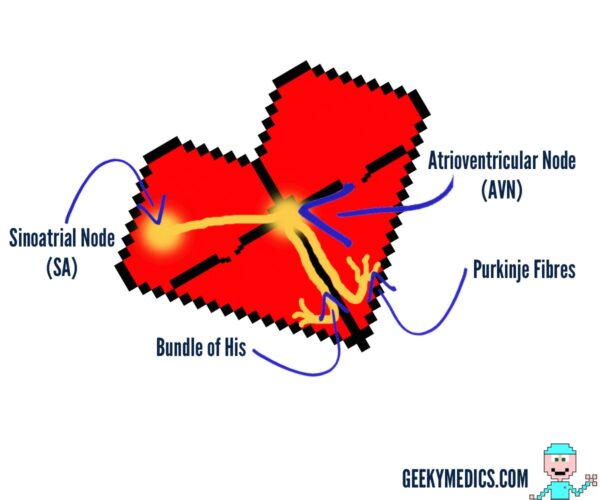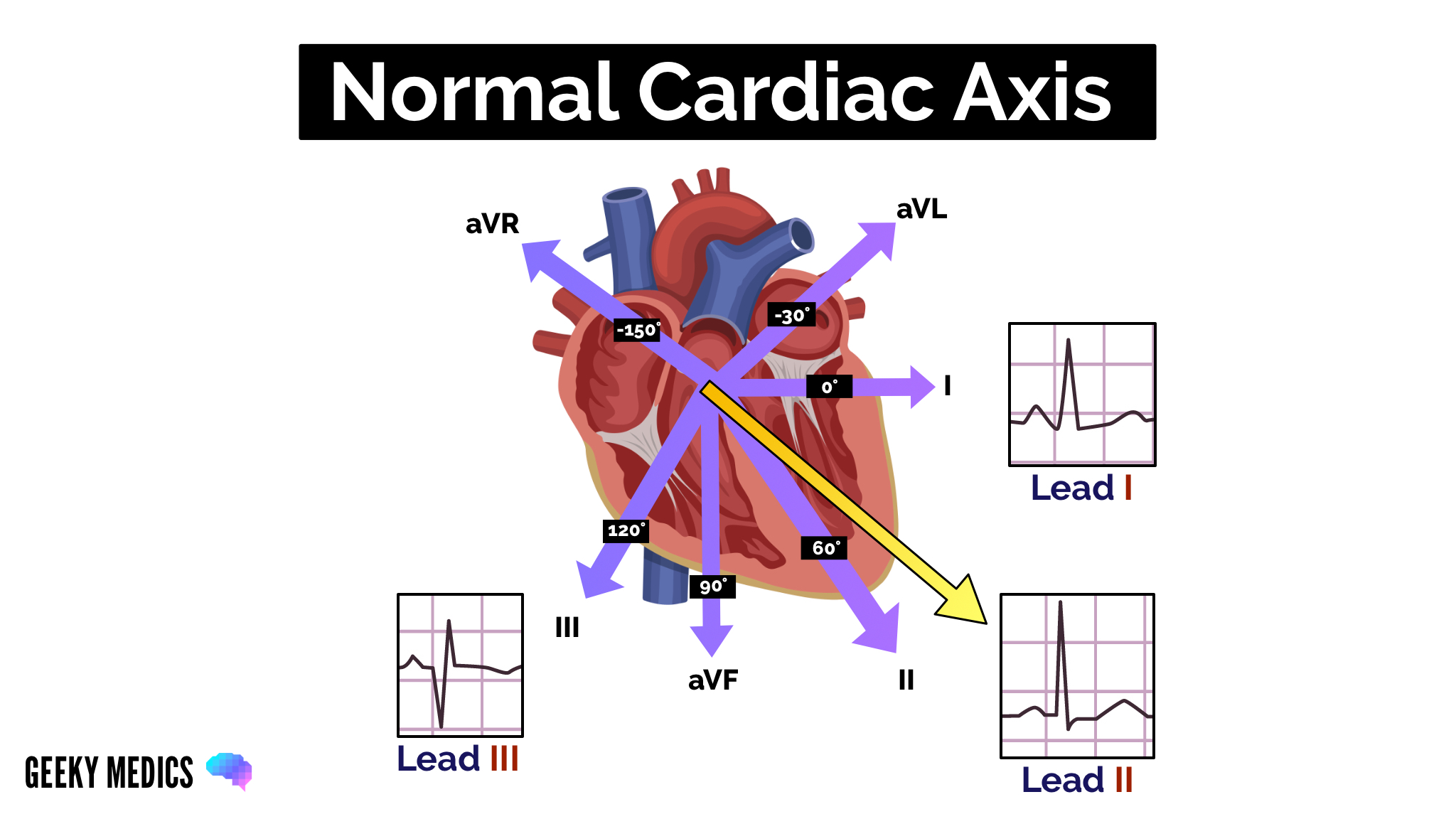How to Read an Ecg for Dummies
What is an ECG?
ECG is the abbreviated term for an electrocardiogram. Information technology is used to tape the electrical activity of the center from different angles to both identify and locate pathology. Electrodes are placed on unlike parts of a patient'south limbs andchest to tape the electric action.
Check out our ECG quiz on the Geeky Medics quiz platform to put your knowledge to the test.
You may besides exist interested in our ECG flashcard deck which can be purchased as part of our drove of 2000+ OSCE flashcards.
Parts of the ECG explained
P waves
P waves represent atrial depolarisation.
In healthy individuals, there should be a P wave preceding each QRS complex.
PR interval
The PR interval begins at the star t of the P wave and ends at the starting time of the Q moving ridge.
It represents the time taken for electrical activeness to motility between the atria and the ventricles.
QRS circuitous
The QRS circuitous represents depolarisation of the ventricles.
It appears as three closely related waves on the ECG (the Q, R and S moving ridge).
ST segment
The ST segment starts at the end of the S wave andends at the starting time of the T wave.
The ST segment is an isoelectric line that represents the fourth dimension between depolarisation and repolarisation of the ventricles (i.e. ventricular contraction).
T wave
The T moving ridge represents ventricular repolarisation.
Information technology appears as a small wave after the QRS circuitous.
RR interval
The RR interval begins at the peak of one R wave and ends at the peak of the next R wave.
Information technology represents the time between ii QRS complexes.
QT interval
The QT interval begins at the start of the QRS complex and finishes at the terminate of the T wave.
It represents the fourth dimension taken for the ventricles to depolarise and then repolarise.
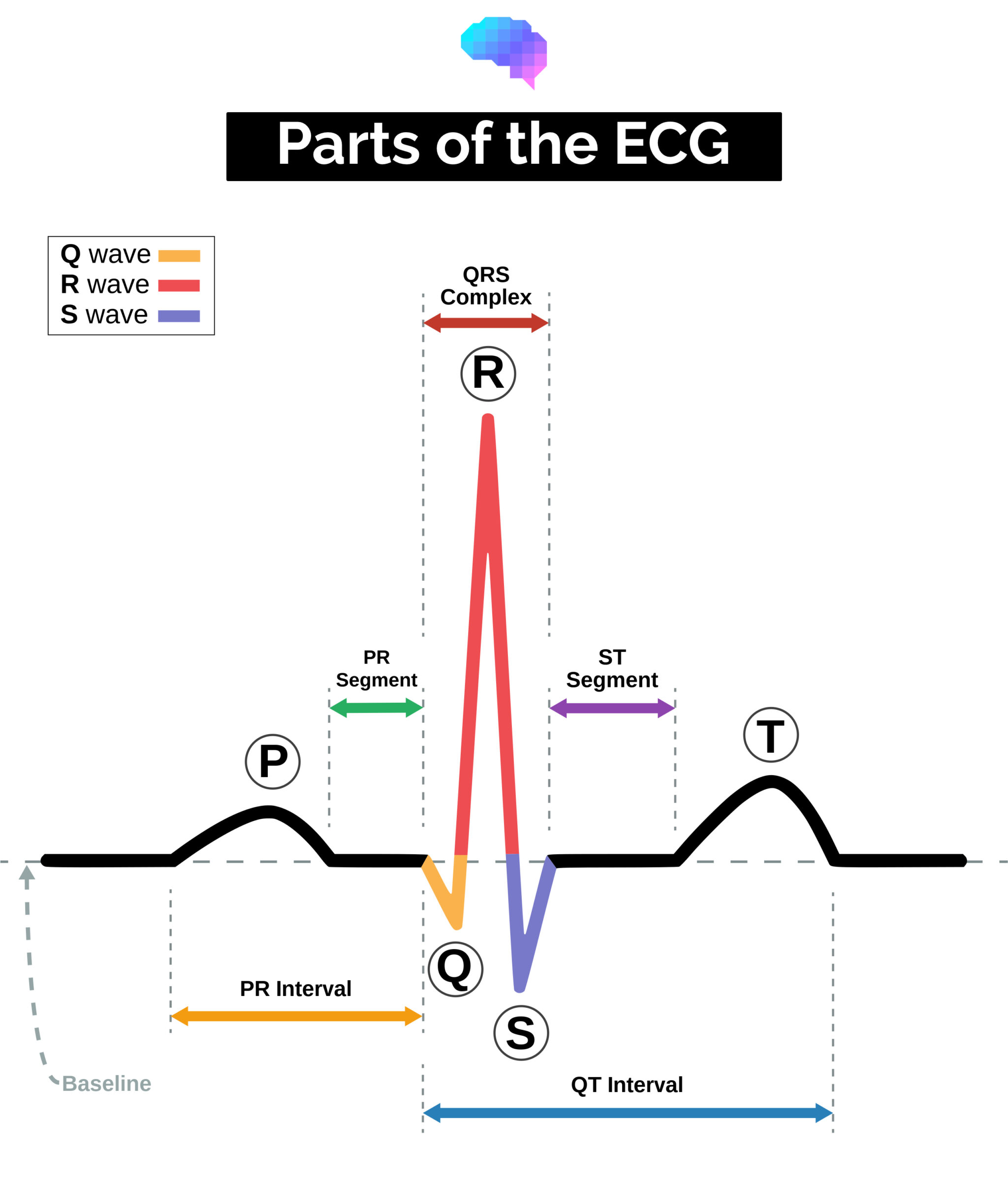
How to read ECG paper
The paper used to record ECGs is standardised across most hospitals and has the following characteristics:
- Each minor square represents 0.04 seconds
- Each large square represents 0.2 seconds
- v large squares = ane 2nd
- 300 large squares = ane minute
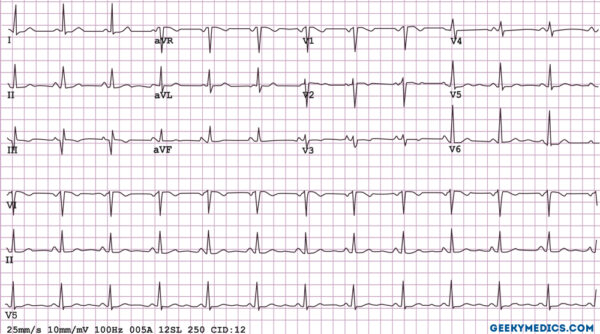
How the 12 lead ECG works
It is important to understand the departure betwixt an ECG electrode and an ECG lead.
An ECG electrode is a conductive pad that is attached to the skin to record electrical activity.
An ECG atomic number 82 is a graphical representation of the heart's electrical activity which is calculated by analysing data from several ECG electrodes.
A 12-atomic number 82 ECG records 12 leads, producing 12 carve up graphs on a slice of ECG newspaper.
Merely 10 physical electrodes are attached to the patient, to generate the 12 leads.
Electrodes
An ECG electrode is a conductive pad that is attached to the peel to record electric activity.
The information gathered from these electrodes allows the 12 leads of the ECG to be calculated (e.g. atomic number 82 I is calculated using information from the electrodes on both the right and left arm).
The electrodes used to generate a 12 lead ECG are described beneath.
Breast electrodes
In that location are 6 chest electrodes:
- V1:fourth intercostal space at the right sternal border
- V2:quaternary intercostal space at the left sternal edge
- V3:midway between the V2 and V4 electrodes
- V4:5th intercostal space in the midclavicular line
- V5:left anterior axillary line at the same horizontal level as V4
- V6:left mid-axillary line at the same horizontal level as V4 and V5
Y'all might also be interested in our OSCE Flashcard Drove which contains over 2000 flashcards that cover clinical test, procedures, advice skills and information interpretation.
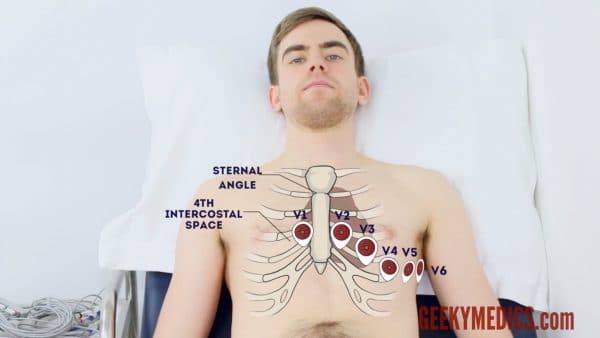
Limb electrodes
At that place are four limb electrodes:
- Cerise (RA): on the ulnar styloid procedure of the correct arm
- Yellow (LA): on the ulnar styloid process of the left arm
- Green (LL): on the medial or lateral malleolus of the left leg
- Blackness (RL): on the medial or lateral malleolus of the right leg
Leads
An ECG lead is a graphical representation of the center's electrical activity which is calculated past analysing data from several ECG electrodes.
Breast leads
- V1: septal view of the heart
- V2: septal view of the heart
- V3: anterior view of the middle
- V4: anterior view of the middle
- V5: lateral view of the heart
- V6: lateral view of the heart
Other leads
- Lead I: lateral view (calculated by analysing activeness between the RA and LA electrodes)
- Lead II: inferior view (calculated by analysing action between the RA and LL electrodes)
- Atomic number 82 III: inferior view (calculated by analysing activeness betwixt the LA and LL electrodes)
- aVR: lateral view (calculated by analysing activity betwixt LA+LL -> RA)
- aVL: lateral view (calculated by analysing action between RA+LL -> LA)
- aVF: inferior view (calculated by analysing activity between RA+LA -> LL)
The shape of the ECG waveform
Each individual lead's ECG recording is slightly different in shape. This is because each lead is recording the electrical action of the heart from a different direction (a.one thousand.a viewpoint).
When the electric activeness within the center travels towards a lead you go a positive deflection.
When the electric activity within the centre travels abroad from a lead you go a negative deflection.
In reality, electrical activity in the eye flows in many directions simultaneously.
Each deflection (a.k.a. moving ridge) on the ECG represents the average management of electric travel (which is calculated using mathematical formulae by the ECG auto).
The peak of the deflection represents the amount of electric activity flowing in that direction (i.due east. the college the deflection, the greater the amount of electrical activeness flowing towards the lead).
The lead with the nigh positivedeflection is most aligned with the direction the center's electrical action is travelling.
If the R wave is greater than the Southward wave information technology suggests depolarisation is moving towards that lead.
If the S wave is greater than the R waves it suggests depolarisation is moving away from that atomic number 82.
If the R and S waves are of equal size it ways depolarisation is travelling at exactly 90° to that lead.
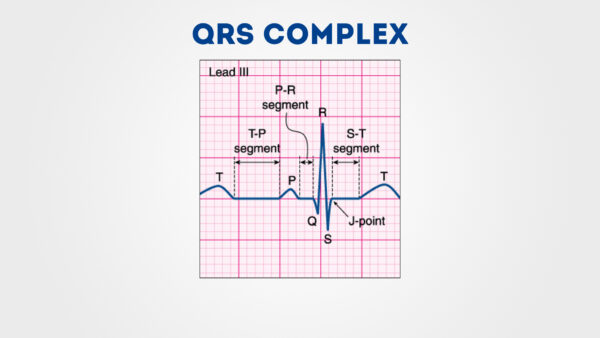
Localising pathology on the ECG
It's of import to understand which leads represent which anatomical territory of the heart, as this allows yous to localise pathology to a particular heart region.
For case, if in that location is ST summit in leads V3 and V4 it suggests an anterior myocardial infarction (MI). You can then combine this with some anatomical knowledge of the eye's blood supply, to allow yous to work out which artery is likely to exist affected (eastward.g. left anterior descending avenue).
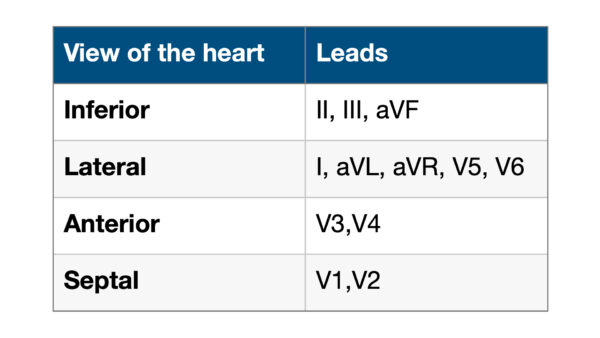
Cardiac centrality
In healthy individuals, the electrical activity of the center begins at the sinoatrial node then spreads to the atrioventricular (AV) node. Information technology then spreads downwardly the bundle of His and then Purkinje fibres to cause ventricular contraction.
Whenever the direction of electric activity moves towards a pb, a positive deflection is produced.
Whenever the direction of electrical activeness moves away from a lead a negative deflection is produced.
The cardiac centrality gives united states of america an idea of the overall direction of electric activity.
Normal cardiac axis
In good for you individuals, you would look the cardiac axis to lie between -thirty°and +90º. The overall direction of electrical activeness is therefore towards leads I, Two andIii (the yellow arrow below). Equally a consequence, you see a positive deflection in all these leads, with lead II showing the most positive deflection equally it is the nigh closely aligned to the overall direction of electric spread. You would look to encounter the most negative deflection in aVR. This is due to aVR providing a viewpoint of the heart from the opposite direction.
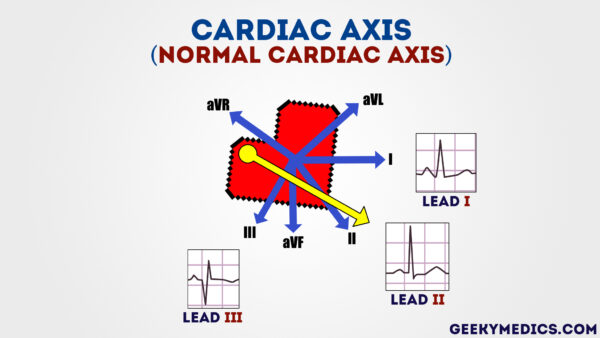
Right axis departure
Right axis deviation (RAD) involves the direction of depolarisation being distorted to the right (betwixt +90º and +180º).
The most common cause of RAD is right ventricular hypertrophy. Extra correct ventricular tissue results in a stronger electrical betoken beingness generated by the right side of the heart. This causes the deflection in lead I to becomenegative and the deflection in lead aVF/3 to existmore positive.
RAD is usually associated with conditions such as pulmonary hypertension, as they crusade correct ventricular hypertrophy. RAD tin can, yet, be a normal finding in very tall individuals.
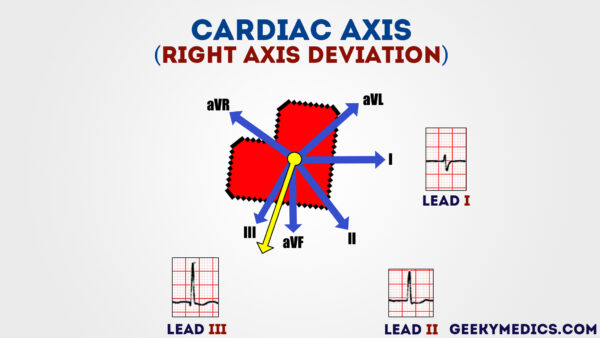
Left axis difference
Left axis deviation (LAD) involves the direction of depolarisation being distorted to the left (between -30° and -90°). This results in the deflection of lead Three becoming negative (this is but considered pregnant if the deflection of pb Ii also becomes negative). LAD is usually caused by conduction abnormalities.
Want to learn more than about ECGs?
We have several other articles relevant to ECGs:
- How to read an ECG: a step by step guide to reading ECGs
- Cardiac axis explained: a unproblematic guide to cardiac axis
- How to document an ECG: a guide to documenting your ECG interpretation in the notes
References
- Michael Rosengarten BEng, Md.McGill. Right axis departure. Licence: CC Past-SA three.0.
- Michael Rosengarten BEng, Doc.McGill. Left centrality divergence. Licence: CC BY-SA 3.0.
Reviewer
Dr Matthew Jackson
Consultant Interventional Cardiologist
Source: https://geekymedics.com/understanding-an-ecg/
